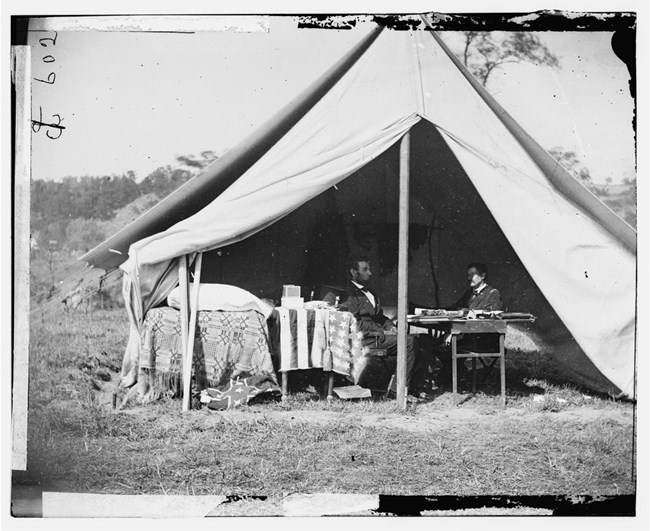
Library of Congress There is a strong presidential connection to the Antietam Battlefield. . .In addition to future president William McKinley serving as a commissary sergeant in the 23rd Ohio during the battle, no less than eight sitting presidents have visited the Antietam battlefield. 
Library of Congress Grant toured the battlefield on October 15, 1869, with his good friend William T. Sherman. One can just imagine the conversation: "Boy, if I were here, Cump, I would have pitched right in!" The trend of presidents visiting Antietam stopped for a while after Grant. . .no Rutherford B. Hayes, no James Garfield nor Chester Arthur, not even Grover Cleveland or Benjamin Harrison. But then, William McKinley made a return visit. 
Library of Congress President McKinley returned to the Antietam battlefield on May 30, 1900--Memorial Day--to deliver an address at the unveiling of the Maryland State Monument. Interestingly, among McKinley's guest of honors were Mr. and Mrs. James Longstreet. The next president to visit Antietam was McKinley's successor, the old Rough Rider himself, Theodore Roosevelt. Born in 1858, Teddy was too young to serve in the Civil War, but he did vividly remember watching the Lincoln Funeral cortege make its way through the streets of New York from his parents' bedroom window in May 1865. He visited the battlefield on September 17, 1903, to deliver a speech at the dedication of New Jersey's state monuments. Once again, following Teddy's visit a number of years passed before another presidential trip to the Antietam battlefield. In fact, it wasn't until 1937. On the 75th Anniversary of the battle, President Franklin Delano Roosevelt delivered an eloquent address to an estimated crowd of some 50,000, and even spent some time shaking hands with a few Civil War veterans. Roosevelt paid a second visit to the battlefield on May 28, 1944. . .just a week and a half before D-Day. 
Library of Congress Kennedy toured the battlefield with his wife Jackie and brother Ted on April 3, 1963, just seven months before his fateful ride in Dallas. They made the trip by helicopter from Camp David to the battlefield. Of particular interest to the Kennedys during their visit were stories of the Irish Brigade and the role of the Massachusetts soldiers. Head over to the JFK Presidential Library site to see some excellent video footage of the visit. Jimmy Carter was the eighth--and last--sitting president to visit the Antietam battlefield. He did so with his wife Rosalynn and historian Shelby Foote in July 1978. The story goes that as the presidential motorcade made its way from Harper's Ferry up Maryland Route 230, it was stopped for the more than 20 minutes by a herd of cattle crossing the road. |
Last updated: February 17, 2020
